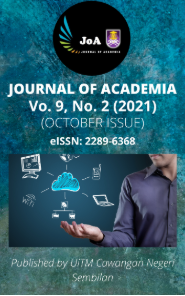HOW INFORMATION ASYMMETRY AND CYBERCRIMINAL RISK AFFECT VOLATILITY AND RETURN OF CRYPTOCURRENCIES
Keywords:
Cryptocurrency, cybercriminal, volatility, cumulative abnormal return, EGARCH-GEDAbstract
This research studies the factors that affect volatility in cryptocurrency markets. The relationship
between information asymmetry and cybercriminal risks are studied against the volatility and return of
cryptocurrencies, namely, Bitcoin (BTC), Ethereum (ETH), Bitcoin Cash (BCH) dan Ripple (XRP).
These cryptocurrencies are selected as they are cryptocurrencies that are being traded by Luno, Sinergy
and Tokenzie (the exchange companies regulated by the Securities Commissions of Malaysia). 730
observations were collected for each cryptocurrency via the CoinMarketCap website, from 1 January
2019 to 30 December 2020. The ADF test and the Kolmogorov-Smirnov test have been conducted
before the analysis of the data. The results show the stationarity and non-normality of the data collected.
The EGARCH-GED model is used to analyse the relationship between information asymmetry and
volatility. The findings indicate a significant relationship between information asymmetry and volatility
in BTC, ETH ad XRP. The Event Study Method (ESM) is used to analyse the effect of cybercriminal
risks on returns. The result shows that all four cryptocurrencies show a significant relationship between
cybercriminal risks and returns.
References
Al-Hajri, H. H., Al-Mughairi, B. M., Hossain, M. I., and Karim, A. M. (2019). Crypto Jacking a Technique to
Leverage Technology to Mine CryptoCurrency. International Journal of Academic Research in Business and
Social Sciences, 9(3), 1210-1221.
Anifowose, M. (2016). Information Asymmetric Effect on the Stock Return Volatility in Nigerian Capital Market.
Accounting Frontier, 14(2), 47-64.
Ante, L. (2020). Bitcoin transactions, information asymmetry and trading volume. Quantitative Finance and
Economics, 4(3), 365-381.
Bentes, S. R. and Cruz, M. M. D. (2011). Is Stock Market Volatility Persistent? A Fractionally Integrated
Approach. Economics, 1-22.
Bollerslev, T. (1986). Generalized autoregressive conditional heteroskedasticity. Journal of Econometrics, 31,
-327.
Carlin, D., O’Kane, P., Sezer, S., and Burgess, J. (2018). Detecting Cryptomining Using Dynamic Analysis. Paper
presented at 2018 16th Annual Conference on Privacy, Security and Trust (PST).
Cook, S. (2020, November 10). Malware statistics and facts for 2020. Retrieved November 23, 2020, from
https://www.comparitech.com/antivirus/malware-statistics-facts/
Corbet, S., Cumming, D. J., Lucey, B. M., Peat, M., and Vigne, S. A. (2018). Investigating the Dynamics Between
Price Volatility, Price Discovery, and Criminality in cryptocurrency Markets. SSRN, 1-57. Retrieved December
, 2020, from https://dx.doi.org/10.2139/ssrn.3384707
Devi, V. (2020, September 1). Cryptocurrency premises raided for stealing electricity. The Star. Retrieved
November 8, 2020, from https://www.thestar.com.my/metro/metro-news/2020/09/01/cryptocurrency-premises
raided-for-stealing-electricity
Fakhfekh, M. and Jeribi, A. (2020). Volatility dynamics of crypto-currencies’ returns: Evidence from asymmetric
and long memory GARCH models. Research in International Business and Finance, 51, 1-10.
Fama, E. F. (1998). Market efficiency, long-term returns, and behavioral finance. Journal of Financial Economics,
, 283-306.
Fousekis, P., and Tzaferi, D. (2020). Returns and volume: Frequency connectedness in cryptocurrency markets.
Economic Modelling, 95, 13-20. https://doi.org/10.1016/j.econmod.2020.11.013.
Grobys, K. (2019). When the blockchain does not block: On hackings and uncertainty in the cryptocurrency
market. University of Vaasa, Finland. Retrieved December 17, 2020, https://dx.doi.org/10.2139/ssrn.3555667
Katsiampa, P., Gkillas, K., and Longin, F. (2018). Cryptocurrency Market Activity During Extremely Volatile
Periods. SSRN. Retrieved November 3, 2020, from http://dx.doi.org/10.2139/ssrn.3220781
Liew, J. K. S., Li, R. Z., Budavari, T., and Sharma, A. (2019). Cryptocurrency Investing Examined. The Journal
of the British Blockchain Association, 2(2), 1-12.
Lopatto, E. (2020, December 22). SEC says third-largest cryptocurrency was sold all wrong. The Verge. Retrieved
December 30, 2020, from https://www.theverge.com/2020/12/22/22196064/ripple-sec-cryptocurrency-security
currency-xrp
Lyocsa, S., Molnar, P., Plihal, T., and Siranova, M. (2020). Impact of macroeconomic news, regulation and hacking
exchange markets on the volatility of bitcoin. Journal of Dynamics and Control, 119, 103980. Retrieved December
, 2020, from https://doi.org/10.1016/j.jedc.2020.103980
MacKinnon, J. G. (1991). Critical values for cointegration tests. In Eds.), Long-Run Economic Relationship:
Readings in Cointegration.
McWharter, N. (2018). Bitcoin and Volatility: Does the Media Play a Role? Economics Student Theses and
Capstone Projects.
Meikeng, Y. (2020, April 12). Cybersecurity cases rise by 82.5%. The Star. Retrieved April 12, 2020 from
https://www.thestar.com.my/news/focus/2020/04/12/cybersecurity-cases-rise-by-825
Nelson, D. B. (1991). Conditional Heteroskedasticity in Asset Returns: A New Approach. Econometrica, 59(2),
-370.
Nelson, D. B. and Cao, C. (1992). Inequality Constraints in the Univariate GARCH Model. Journal of Business
and Economic Statistics, 10(2), 229-235.
Othman, A. H. A., Alhabshi, S. M., and Haron, R. (2019). The effect of symmetric and asymmetric information
on volatility structure of crypto-currency markets. Journal of Financial Economic Policy, 11(3), 432-450.
Park, M., and Chai, S. (2020). The Effect of Information Asymmetry on Investment Behaviour in Cryptocurrency
Market. Paper presented at the proceedings of the 53rd Hawaii International Conference on System Sciences.
Saens, R. and Sandoval, E. (2005). Measuring Security Price Performance Using Chilean Daily Stock Returns:
The Event Study Method. Cuadernos de Economia, 42, 307-328.
Sarawak Energy nabs five cryptocurrency operators stealing state electricity supply. (2020, August 12). Malay
Mail. Retrieved November 8, 2020, from https://www.malaymail.com/news/malaysia/2020/08/12/sarawak
energy-board-nabs-five-cryptocurrency-operators-stealing-state-elec/1893370
Storsveen, M., and Veliqi, F. (2020). The Impact of Cryptocurrency-Related Cyberattacks on Cryptocurrencies
and Traditional Financial Assets. Unpublished master’s thesis, University of Stavanger, Norway, Europe.
Tissaoui, K., Zaghdoudi, T., and Alfreahat, K. I. (2020). Can intraday public information explain Bitcoin Returns
and Volatility? A PGARCH-Based Approach. Economics Bulletin, 40(3), 2085-2092.
Tweneboah-Koduah, S. and Atsu, F. (2020). Reaction of Stock Volatility to Data Breach: An Event Study.
Journal of Cyber Security and Mobility, 9(3), 1-19.
Wanguba, J. (2020, December 2). How Many Cryptocurrencies Are There In 2020? E-Crypto News. Retrieved
November 8, 2020, from https://e-cryptonews.com/how-many-cryptocurrencies-are-there-in-2020/
Downloads
Published
Issue
Section
License
Copyright (c) 2021 Journal of Academia

This work is licensed under a Creative Commons Attribution-NonCommercial-NoDerivatives 4.0 International License.












